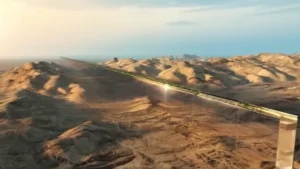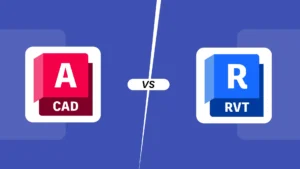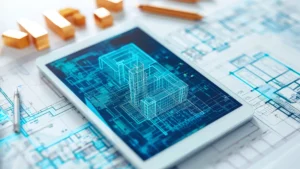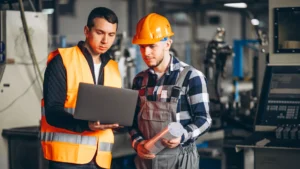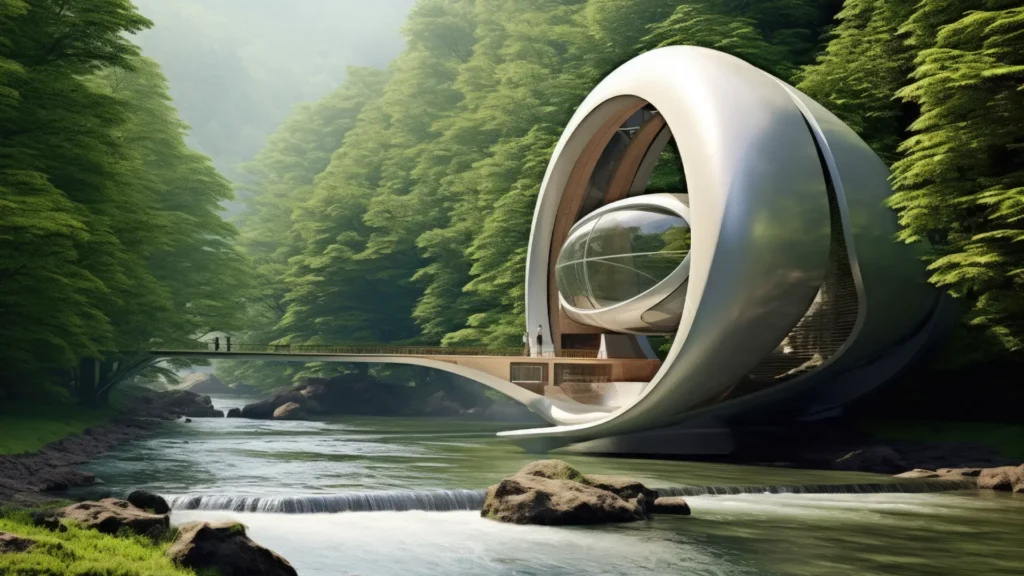In-Depth Look at Gsource’s Architectural Design – From Sketch to Reality
Introduction
In the ever-changing field of architecture and its processes, what separates Gsource? Our creative, customer-focused approach guarantees each project is a functional and artistic masterpiece. The architectural process involves making different design sets, sketches, and documents, obtaining legal permissions, and whatnot. We create from Schematic Designs to final As-builts, and here is how we do that.
Come along with us as we walk you through every stage of our architectural process, from the initial drawing to the finished building, and see how we turn concepts into real, exquisite environments.
Steps to Architectural Design Process at Gsource
Step 1 – List of Documents Before we begin sketching, there is a list of legal documents collected from the client. These are documents about the plot or area where the structure will be built. Documents that we collect are –
- Site Surveys
- Boundary Layout
- Title Deeds
- NOCs (No Objection Certificates)
- Land Use Permits
- Encumbrance Certificate
Apart from these, we collect any other legal documents required. Getting this legal paperwork together before beginning an architectural project helps to prevent legal issues or delays and guarantees that the project complies with the law. Every document offers vital information that affects the planning, design, and construction stages and guarantees a seamless and legally sound project development procedure.
Step 2 – Design Information from the Client
Moving forward, we ask the client about the design idea and what structure idea they have. We need to understand from the client the purpose and use of the structure they want whether it will be a residential, commercial, or mixed-use building.
If it is a residential project, the number of floors, the number of rooms, washrooms, halls, private areas, public areas, semi-public areas, any specific room or floor like the gym, swimming pool, rooftop garden, or any other requirements that the client has from the structure are noted down. For a commercial building, the number of conference rooms, meeting rooms, floors, occupants, and other such details are taken from the client.
Along with this, the specific design requirements of the theme for the structure, like contemporary, minimalist, boho, or other specifics, are considered. This also involves taking reference images from the client to illustrate the idea of their design. Other details from the client including the color, finishes, textures, materials, specific decor requirements, parking area requirements, sustainability or energy-saving feature requirements, any ideas for a smart home, or other design requirements, are taken down.
This knowledge from the client helps the architects, designers, engineers, and contractors understand the project in depth.
Step 3 – Zoning
Now, as we have the idea of the use and design of the structure, we begin with the Zoning process. Zoning involves the segregation of the areas on the site according to the building requirements. It is a block layout of the structure with a design-wise orientation considering common, public, semi-public, and private spaces.
These block layouts are made in 2 to 3 different ways, changing the position of doors, walls, and other details in the design. This gives the client options to choose from and get the right one for them. Also, this helps to get a raw idea of the structure before the final sketch is made. Doing so makes it easier to determine whether the design adheres to building codes, local laws, and other requirements. After we have finalized the Zoning idea and base for the designs, we move on to the next step, making the SD (Schematic Development) sets.
Step 4 – Schematic Development (SD) Sets
In the next step we start with creating the Schematic Development or Schematic Design (SD) sets for the client. These SDs are sketches and detailed conceptual drawings of the basic idea and zoning instructions taken from the client.
It outlines the basic objectives of the project as well as its conceptual design, which includes the structure’s measurements, spatial relationships, and overall look. Site plans, floor plans, sections, elevations, preliminary structural designs, 3D views, renderings, basic system layouts, and other thorough descriptions are all included in this. The client can better grasp the entire structure and its details from these design explanations.
This also includes the size of the door, window, stairs, and other elements, along with the length, width, height, and other details. These are added to the final SD of the structure, known as the SD set for the same.
Once these are submitted to the client, they decide on the final SD set, and then the contractors and architects move on to the Design Development part.
Step 5 – Design Development (DD) Sets
After the SD sets are finalized, we make the Design Development (DD) sets for the client, which are divided into two phases.
Phase 1
Design Development involves making the Schematic Designs more detailed. This includes making different system details in the design, like the MEPF system, framings, foundations, lighting placements, fixing the material and color palette of the structure, detailed floor plans, elevations, sections, the number of rooms, bedrooms, bathrooms, and more. Overall, this plan confirms all the interior and exterior details of the structure.
This makes the client understand what they want and what we have understood from their description of the design. After this is done, the second phase of the design comes into view.
Phase 2 – Plan Approval
In this phase, the design developed from the client’s vision is created from the approval point of view of the area officials. The plan here freezes, and no major changes could be made to the design approved by the client. Here, the following things are taken into consideration –
1. Specialist Consultations
Coordination with consultants like contractors, structural engineers, MEPF engineers, landscape architects, and other specialists to confirm the design and details of the structure.
2. Adherence to building codes
Complying the design with the building codes and regulations, including Zoning Laws and land use regulations.
3. Pending Approvals
If there are any permits and approvals remaining, they are prepared and submitted to the respected personnel or authority.
4. Design Finalization
Completing the design and finally getting it approved by the client.
This stage guarantees that the design is finished, integrated, and prepared for the construction document preparation process. After we have made the SD and DD sets for the construction, these need to get government approval. It is necessary to ensure the legality of the construction being done. After getting the approval from the designated personnel, we move on to the making of Construction Documents (CD) Sets.
Step 6 – Construction Documentation (CD) Sets
All discipline drawings and sketches are coordinated in the Construction Documentation (CD) sets before the final construction. Before construction starts, the Mechanical, Electrical, Plumbing, and Fire Protection (MEPF) designs are aligned with each other as-built.
All the information required for builders and contractors to comprehend, bid on, and build the structure according to the plan is contained in the CD set. These records guarantee that the project is constructed according to the architect’s plan and all relevant legal and industrial requirements.
The following is the list of drawings and documents to be involved while making the CD sets –
1. Architectural Drawings – Site Plan, Floor Plans, Elevations, Sections, and Details.
2. Structural Drawings – Foundation Plans, Framing Plans, and Structural Details.
3. Mechanical, Electrical, Plumbing, and Fire Protection (MEPF) Drawings.
4. Interior Design Drawings – Interior Elevations, Furniture Layout Plans, and Reflected Ceiling Plans.
5. Schedules – Door and Window Schedules, Finish Schedules, Lighting and Fixture Schedules, and Equipment Schedules.
6. Specifications – Project Manual and Product Specifications.
7. Legal and Regulatory Documents – Building Permits and Code Compliance Documentation.
8. Bidding and Contract Documents – Bid Forms and Contract Agreements.
The CD set decreases uncertainty, lowers the possibility of mistakes, and aids in keeping the project on schedule and under budget by offering a clear and thorough plan for construction. After this, we move to the final step in the architectural process.
Step 7 – Final As-builts
In the final step, after the construction is completed, we make the final As-builts of the structure. This includes all the changes that are made during the construction. These changes are recorded and documented while the construction is going on and then included in the final drawings or As-builts of the structure.
These drawings are important, both legally and in terms of future maintenance and repairs. With the ability to record any changes made to the original plans, as-builts are the definitive and precise record of the finished building. In the future, they will come in very handy since a comprehensive grasp of the building’s real construction will be necessary for any repairs, restorations, or maintenance work.
After the completion of the construction process, As-builts, along with the SD, DD, and CD sets, are submitted to the client, contractors, architects, and other stakeholders for their future use.
Conclusion
As we reach the end of our architectural journey at Gsource, it’s clear that every project succeeds because of our meticulous and methodical approach. We take you step-by-step through the entire process, from the original concept to the finished building. Our approach ensures that we will carefully and precisely realize your idea. All set to bring your vision to life? Turn your dream building into a magnificent reality by letting Gsource help you with every stage of the process, from conception to completion!



